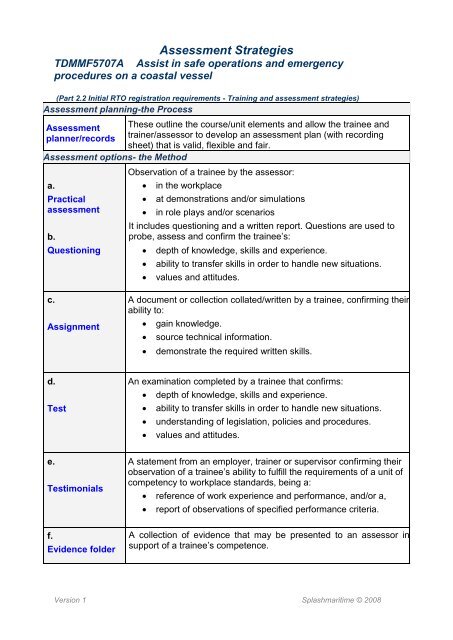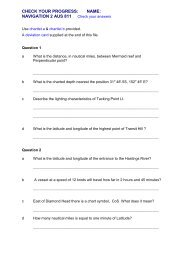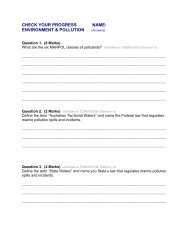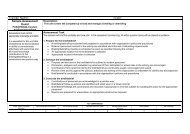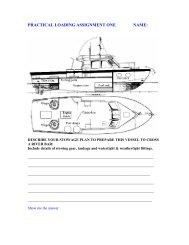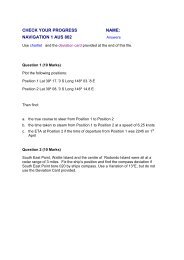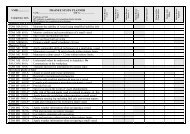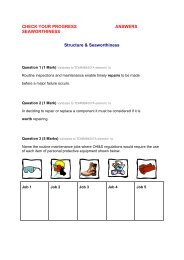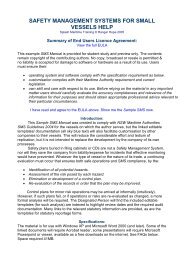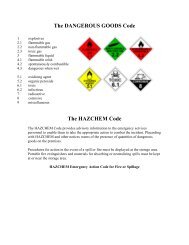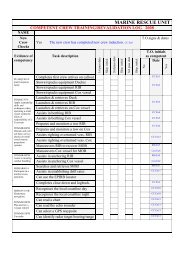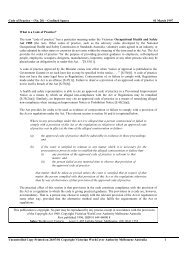aTDMMF5707AAssistsaf.. - Splash Maritime Training
aTDMMF5707AAssistsaf.. - Splash Maritime Training
aTDMMF5707AAssistsaf.. - Splash Maritime Training
Create successful ePaper yourself
Turn your PDF publications into a flip-book with our unique Google optimized e-Paper software.
Assessment Strategies<br />
TDMMF5707A Assist in safe operations and emergency<br />
procedures on a coastal vessel<br />
(Part 2.2 Initial RTO registration requirements - <strong>Training</strong> and assessment strategies)<br />
Assessment planning-the Process<br />
Assessment<br />
planner/records<br />
Assessment options- the Method<br />
a.<br />
Practical<br />
assessment<br />
b.<br />
Questioning<br />
These outline the course/unit elements and allow the trainee and<br />
trainer/assessor to develop an assessment plan (with recording<br />
sheet) that is valid, flexible and fair.<br />
Observation of a trainee by the assessor:<br />
<br />
<br />
<br />
in the workplace<br />
at demonstrations and/or simulations<br />
in role plays and/or scenarios<br />
It includes questioning and a written report. Questions are used to<br />
probe, assess and confirm the trainee’s:<br />
<br />
<br />
<br />
depth of knowledge, skills and experience.<br />
ability to transfer skills in order to handle new situations.<br />
values and attitudes.<br />
c.<br />
Assignment<br />
A document or collection collated/written by a trainee, confirming their<br />
ability to:<br />
<br />
<br />
<br />
gain knowledge.<br />
source technical information.<br />
demonstrate the required written skills.<br />
d.<br />
Test<br />
An examination completed by a trainee that confirms:<br />
depth of knowledge, skills and experience.<br />
ability to transfer skills in order to handle new situations.<br />
understanding of legislation, policies and procedures.<br />
values and attitudes.<br />
e.<br />
Testimonials<br />
f.<br />
Evidence folder<br />
A statement from an employer, trainer or supervisor confirming their<br />
observation of a trainee’s ability to fulfill the requirements of a unit of<br />
competency to workplace standards, being a:<br />
reference of work experience and performance, and/or a,<br />
<br />
report of observations of specified performance criteria.<br />
A collection of evidence that may be presented to an assessor in<br />
support of a trainee’s competence.<br />
Version 1 <strong>Splash</strong>maritime © 2008
Practical &<br />
Questions<br />
Assignment<br />
Test<br />
Testimonial<br />
Evidence folder<br />
Sufficient<br />
Standard assessment planner/record<br />
(Part 2.2 Initial RTO registration requirements - <strong>Training</strong> and assessment strategies)<br />
Course: TDM10107<br />
CERTIFICATE I IN TRANSPORT & DISTRIBUTION (MARITIME OPERATIONS)<br />
Unit: TDMMF5707A Assist in safe operations and emergency procedures on a coastal<br />
vessel<br />
Trainee name:<br />
Assessor name:<br />
Trainee number:<br />
Instructions & Context: At RTO and on a real/simulated small commercial vessel<br />
1. Circle yes/no to indicate sufficient evidence for<br />
competency.<br />
Evidence method<br />
2. Evaluate on the evidence provided and circle NYC or C.<br />
1<br />
3. Complete the comment section detailing areas requiring<br />
further evidence and/or training.<br />
1.a<br />
Task<br />
Implement basic safety practices and procedures<br />
Available information on basic safety and hazard control<br />
practices/ procedures on vessel is obtained/ interpreted<br />
Basic safety practices, precautions and procedures are<br />
1.b applied when assisting other members of the crew in<br />
operations on a coastal vessel<br />
2 Locate and use personal safety equipment<br />
2.a<br />
2.b<br />
The location of personal safety equipment on a vessel is<br />
checked and noted<br />
Information on the use of the personal safety equipment<br />
is obtained from the master or senior members of crew<br />
The use of personal safety equipment is correctly<br />
2.c demonstrated as per company procedures and<br />
regulatory requirements<br />
3 Apply basic seamanship skills applicable to a deckhand<br />
Yes<br />
No<br />
Yes<br />
No<br />
Yes<br />
No<br />
Yes<br />
No<br />
Yes<br />
No<br />
3.a<br />
3.b<br />
3.c<br />
4<br />
4.a<br />
Procedures for the safe mooring, anchoring and<br />
berthing of coastal vessels are interpreted and applied<br />
during vessel operations<br />
Basic rope handling skills are safely performed during<br />
vessel operations<br />
Items of deck equipment are cared for and stored in<br />
Yes<br />
accordance with company procedures and good<br />
seamanship practice<br />
No<br />
Assist in the use of basic firefighting equipment available on a coastal vessel<br />
Information on procedures in the event of a fire<br />
emergency on the vessel is obtained from the skipper or<br />
Version 1 <strong>Splash</strong>maritime © 2008<br />
Yes<br />
No<br />
Yes<br />
No<br />
Yes<br />
No
4.b<br />
4.c<br />
5<br />
5.a<br />
5.b<br />
5.c<br />
senior members of crew or from published information<br />
or signage on the vessel and is correctly interpreted and<br />
applied<br />
The location of firefighting equipment on a vessel is<br />
checked and identified<br />
Assistance in the use of portable firefighting equipment<br />
is correctly demonstrated as per operating instructions<br />
Provide assistance in the event of an emergency<br />
Emergency situations are correctly recognised and<br />
appropriate responses made<br />
Assistance is provided in crowd control in emergency<br />
situations in accordance with established vessel<br />
procedures<br />
Correct action is taken on discovery of an actual or<br />
potential emergency in accordance with established<br />
vessel procedures<br />
6 Assist in vessel abandonment procedures<br />
6.a<br />
6.b<br />
Information on procedures in the event of vessel<br />
abandonment is obtained from the master or senior<br />
members of crew or published information or signs on<br />
the vessel and is correctly interpreted<br />
Appropriate assistance is provided in the use of survival<br />
equipment on a vessel<br />
Participation in abandon vessel drills confirms readiness<br />
6.c to correctly carry out appropriate assistance in the event<br />
of vessel abandonment<br />
Assessment event planner<br />
Assessment<br />
event<br />
Practical<br />
Yes<br />
No<br />
Yes<br />
No<br />
Yes<br />
No<br />
Yes<br />
Content Date/ due Time Duration Location What to bring<br />
Assignment n/a n/a<br />
Test<br />
Completed<br />
assignment<br />
Testimonial n/a n/a Testimonial<br />
Evidence<br />
Folder<br />
Assessor’s Comments<br />
n/a n/a Folder<br />
No<br />
Yes<br />
No<br />
Yes<br />
No<br />
Yes<br />
No<br />
Yes<br />
No<br />
Yes<br />
No<br />
The Trainee is assessed as (circle option): Competent Not yet competent<br />
Assessor signs:<br />
Date:<br />
I acknowledge receipt of the assessor’s comments and competency determination.<br />
Trainee signs:<br />
Date:<br />
Version 1 <strong>Splash</strong>maritime © 2008
Assessment by practical activity & questioning<br />
(Part 2.3.a Initial RTO registration requirements - Assessment materials)<br />
Course: TDM10107 CERTIFICATE I IN TRANSPORT & DISTRIBUTION (MARITIME OPERATIONS)<br />
Unit: TDMMF5707A Assist in safe operations and emergency procedures on a coastal vessel<br />
Trainee name:<br />
Assessor name:<br />
Location:<br />
Trainee number:<br />
Date:<br />
Instructions for the assessor:<br />
Observe the trainee completing the task.<br />
Circle yes/no for the trainee’s completion of the task to the required standard.<br />
Confirm the trainee’s underpinning knowledge using the questions list. Link<br />
Circle yes/no to show that the trainee answered the questions sufficiently.<br />
Complete the feedback section.<br />
Conditions: ------------------------------------------------------------------------------------------------------------------------------------------------------------------<br />
-----------------------------------------------------------------------------------------------------------------------------------------------------------------------------------<br />
1<br />
1.a<br />
1.b<br />
2<br />
Task Criteria Yes No<br />
Implement basic safety practices and procedures<br />
Available information on basic safety and hazard control<br />
practices and procedures on a vessel is obtained and<br />
interpreted<br />
Basic safety practices, precautions and procedures are<br />
applied when assisting other members of the crew in<br />
operations on a coastal vessel<br />
Locate and use personal safety equipment<br />
Yes No<br />
Yes No<br />
Version 1 <strong>Splash</strong>maritime © 2008
The location of personal safety equipment on a vessel is<br />
2.a<br />
checked and noted<br />
Information on the use of the personal safety equipment is<br />
2.b<br />
obtained from the master or senior members of crew<br />
The use of personal safety equipment is correctly<br />
2.c demonstrated as per company procedures and regulatory<br />
requirements<br />
Apply basic seamanship skills applicable to a deckhand<br />
3<br />
3.a<br />
3.b<br />
3.c<br />
Procedures for the safe mooring, anchoring and berthing of<br />
coastal vessels are interpreted and applied during vessel<br />
operations<br />
Basic rope handling skills are safely performed during<br />
vessel operations<br />
Items of deck equipment are cared for and stored in<br />
accordance with company procedures and good<br />
seamanship practice<br />
4 Assist in the use of basic firefighting equipment available on a coastal vessel<br />
Information on procedures in the event of a fire emergency<br />
on the vessel is obtained from the skipper or senior<br />
4.a<br />
members of crew or from published information or signage<br />
on the vessel and is correctly interpreted and applied<br />
The location of firefighting equipment on a vessel is<br />
4.b<br />
checked and identified<br />
Assistance in the use of portable firefighting equipment is<br />
4.c<br />
correctly demonstrated as per operating instructions<br />
Provide assistance in the event of an emergency<br />
5<br />
Emergency situations are correctly recognised and<br />
5.a<br />
appropriate responses made<br />
Assistance is provided in crowd control in emergency<br />
5.b situations in accordance with established vessel<br />
procedures<br />
Version 1 <strong>Splash</strong>maritime © 2008<br />
Yes No<br />
Yes No<br />
Yes No<br />
Yes No<br />
Yes No<br />
Yes No<br />
Yes No<br />
Yes No<br />
Yes No<br />
Yes No<br />
Yes No
Correct action is taken on discovery of an actual or<br />
5.c potential emergency in accordance with established vessel<br />
Yes No<br />
procedures<br />
6 Assist in vessel abandonment procedures<br />
Information on procedures in the event of vessel<br />
abandonment is obtained from the master or senior<br />
6.a<br />
members of crew or published information or signs on the<br />
Yes No<br />
vessel and is correctly interpreted<br />
Appropriate assistance is provided in the use of survival<br />
6.b<br />
equipment on a vessel<br />
Yes No<br />
Participation in abandon vessel drills confirms readiness to<br />
6.c correctly carry out appropriate assistance in the event of<br />
Yes No<br />
vessel abandonment<br />
The Trainee’s overall performance was Sufficient Insufficient<br />
Feedback to trainee<br />
----------------------------------------------------------------------------------------------------------------------------------------------------------------------------------<br />
----------------------------------------------------------------------------------------------------------------------------------------------------------------------------------<br />
----------------------------------------------------------------------------------------------------------------------------------------------------------------------------------<br />
----------------------------------------------------------------------------------------------------------------------------------------------------------------------------------<br />
Trainee signs:<br />
Date:<br />
Assessor signs:<br />
Date:<br />
Version 1 <strong>Splash</strong>maritime © 2008
Assessment by confirmation & challenge questions list<br />
(Part 2.3.b Initial RTO registration requirements - Assessment materials)<br />
Course: Certificate One TDM10107 Deckhand<br />
Unit: TDMMF5707A Assist in safe operations and emergency procedures on a coastal<br />
vessel<br />
Trainee name:<br />
Assessor name:<br />
Trainee number:<br />
Assessor Instructions:<br />
Questioning checks a trainee’s underpinning knowledge and provides further evidence to<br />
support practical assessment, testimonials and folders.<br />
The Trainee answered the following questions: Link<br />
1<br />
1.a<br />
1.b<br />
2<br />
Implement basic safety practices and procedures<br />
Available information on basic safety and hazard control practices and<br />
procedures on a vessel is obtained and interpreted<br />
Basic safety practices, precautions and procedures are applied when<br />
assisting other members of the crew in operations on a coastal vessel<br />
Locate and use personal safety equipment<br />
The location of personal safety equipment on a vessel is checked and<br />
2.a<br />
noted<br />
Information on the use of the personal safety equipment is obtained from<br />
2.b<br />
the master or senior members of crew<br />
The use of personal safety equipment is correctly demonstrated as per<br />
2.c<br />
company procedures and regulatory requirements<br />
Perform tasks aloft and over vessel’s side<br />
3<br />
Version 1 <strong>Splash</strong>maritime © 2008<br />
Sufficient<br />
response<br />
Procedures for the safe mooring, anchoring and berthing of coastal Yes No<br />
3.a<br />
vessels are interpreted and applied during vessel operations<br />
3.b Basic rope handling skills are safely performed during vessel operations Yes No<br />
3.c<br />
Items of deck equipment are cared for and stored in accordance with Yes No<br />
company procedures and good seamanship practice<br />
4 Assist in the use of basic firefighting equipment available on a coastal vessel<br />
4.a<br />
4.b<br />
4.c<br />
5<br />
Information on procedures in the event of a fire emergency on the vessel<br />
is obtained from the skipper or senior members of crew or from published<br />
information or signage on the vessel and is correctly interpreted and<br />
applied<br />
The location of firefighting equipment on a vessel is checked and<br />
identified<br />
Assistance in the use of portable firefighting equipment is correctly<br />
demonstrated as per operating instructions<br />
Provide assistance in the event of an emergency<br />
Emergency situations are correctly recognised and appropriate<br />
Yes No<br />
5.a<br />
responses made<br />
5.b Assistance is provided in crowd control in emergency situations in Yes No<br />
Yes<br />
Yes<br />
Yes<br />
Yes<br />
Yes<br />
Yes<br />
Yes<br />
Yes<br />
No<br />
No<br />
No<br />
No<br />
No<br />
No<br />
No<br />
No
5.c<br />
accordance with established vessel procedures<br />
Correct action is taken on discovery of an actual or potential emergency<br />
in accordance with established vessel procedures<br />
6 Assist in vessel abandonment procedures<br />
Information on procedures in the event of vessel abandonment is<br />
6.a obtained from the master or senior members of crew or published<br />
information or signs on the vessel and is correctly interpreted<br />
Appropriate assistance is provided in the use of survival equipment on a<br />
6.b<br />
vessel<br />
6.c<br />
Participation in abandon vessel drills confirms readiness to correctly<br />
carry out appropriate assistance in the event of vessel abandonment<br />
The Trainee’s underpinning knowledge is Sufficient Insufficient<br />
Feedback to trainee<br />
Yes<br />
Yes<br />
Yes<br />
Yes<br />
No<br />
No<br />
No<br />
No<br />
-----------------------------------------------------------------------------------------------------------------------<br />
----------------------------------------------------------------------------------------------------------------------<br />
----------------------------------------------------------------------------------------------------------------------<br />
----------------------------------------------------------------------------------------------------------------------<br />
----------------------------------------------------------------------------------------------------------------------<br />
----------------------------------------------------------------------------------------------------------------------<br />
Trainee signs:<br />
Date:<br />
Assessor signs:<br />
Date:<br />
Version 1 <strong>Splash</strong>maritime © 2008
Assessment by testimonial<br />
(Part 2.3.e Initial RTO registration requirements - Assessment materials)<br />
Course: TDM10107 CERTIFICATE I IN TRANSPORT & DISTRIBUTION (MARITIME OPERATIONS)<br />
Unit: TDMMF5707A Assist in safe operations and emergency procedures on a coastal<br />
vessel<br />
Trainee name:<br />
Trainee number:<br />
Location:<br />
Instructions for the referee:<br />
1. Over a period of time make three observations of the trainee completing a task.<br />
2. Enter the date & conditions on which each observation was made.<br />
3. Tick in the box to show completion of the task to the standard expected.<br />
4. Complete the feedback sections.<br />
Date & Conditions:<br />
Observation 1: -------------------------------------------------------------------------------------------------<br />
----------------------------------------------------------------------------------------------------------------------<br />
Observation 2: --------------------------------- ---------------------------------------------------------------<br />
----------------------------------------------------------------------------------------------------------------------<br />
Observation 3: -------------------------------------------------------------------------------------------------<br />
-----------------------------------------------------------------------------------------------------------------------<br />
Observations of Tasks 1 2 3<br />
Implement basic safety practices and procedures<br />
1<br />
1.a<br />
1.b<br />
2<br />
2.a<br />
2.b<br />
2.c<br />
3<br />
Available information on basic safety and hazard control practices<br />
and procedures on a vessel is obtained and interpreted<br />
Basic safety practices, precautions and procedures are applied<br />
when assisting other members of the crew in operations on a<br />
coastal vessel<br />
Locate and use personal safety equipment<br />
The location of personal safety equipment on a vessel is checked<br />
and noted<br />
Information on the use of the personal safety equipment is<br />
obtained from the master or senior members of crew<br />
The use of personal safety equipment is correctly demonstrated as<br />
per company procedures and regulatory requirements<br />
Apply basic seamanship skills applicable to a deckhand<br />
3.a Procedures for the safe mooring, anchoring and berthing of coastal<br />
vessels are interpreted and applied during vessel operations<br />
3.b Basic rope handling skills are safely performed during vessel<br />
operations<br />
3.c Items of deck equipment are cared for and stored in accordance<br />
with company procedures and good seamanship practice<br />
4 Assist in the use of basic firefighting equipment available on a coastal vessel<br />
Version 1 <strong>Splash</strong>maritime © 2008
4.a Information on procedures in the event of a fire emergency on the<br />
vessel is obtained from the skipper or senior members of crew or<br />
from published information or signage on the vessel and is<br />
correctly interpreted and applied<br />
4.b The location of firefighting equipment on a vessel is checked and<br />
identified<br />
4.c Assistance in the use of portable firefighting equipment is correctly<br />
demonstrated as per operating instructions<br />
5 Provide assistance in the event of an emergency<br />
5.a Emergency situations are correctly recognised and appropriate<br />
responses made<br />
5.b Assistance is provided in crowd control in emergency situations in<br />
accordance with established vessel procedures<br />
5.c Correct action is taken on discovery of an actual or potential<br />
emergency in accordance with established vessel procedures<br />
6 Assist in vessel abandonment procedures<br />
6.a Information on procedures in the event of vessel abandonment is<br />
obtained from the master or senior members of crew or published<br />
information or signs on the vessel and is correctly interpreted<br />
6.b Appropriate assistance is provided in the use of survival equipment<br />
on a vessel<br />
6.c Participation in abandon vessel drills confirms readiness to<br />
correctly carry out appropriate assistance in the event of vessel<br />
abandonment<br />
Referee’s report:<br />
Referee name<br />
Qualifications<br />
Relationship to<br />
Trainee<br />
Contact address<br />
Contact<br />
phone<br />
Referee comments<br />
-----------------------------------------------------------------------------------------------------------------------<br />
----------------------------------------------------------------------------------------------------------------------<br />
----------------------------------------------------------------------------------------------------------------------<br />
Referees Declaration: The information I provided above is true and correct.<br />
Referee’s signs:<br />
Date:<br />
Version 1 <strong>Splash</strong>maritime © 2008
Non Standard and RPL Assessment Record<br />
(Part 2.3.f Assessment materials)<br />
Your folder is a collection of evidence that may be presented to an assessor to prove<br />
your competence at a task.<br />
What evidence can I include?<br />
Evidence<br />
Explanation<br />
Work history Current and previous job descriptions<br />
<strong>Training</strong> logbook<br />
<strong>Training</strong> or<br />
certificates<br />
Journal or diary<br />
Awards<br />
A record that includes details of your:<br />
evidence of you applying your knowledge and skills<br />
completion of tasks to industry standards<br />
contributions to team output<br />
response to critical incidents<br />
Results of courses, training certificates or studies you have<br />
completed that relate to the competency standards.<br />
A record of work roles, tasks and responsibilities, and<br />
contributions to team outputs. You should get your diary / journal<br />
entries signed by a supervisor or experienced colleague.<br />
Awards you have received at work or relevant activities.<br />
Testimonials<br />
Work samples<br />
Photos / videos of<br />
your work<br />
A statement from a competent person confirming their<br />
observation of your ability to fulfill the requirements of a unit of<br />
competency to workplace standards, being a: reference and/or<br />
a, report of observations of specified performance criteria<br />
Items, letters/memos, job specifications, quotes etc.<br />
Describe and date any photos, videos and explain how they<br />
relate to the work.<br />
When collecting evidence and putting it together in your folder you need to inform the<br />
assessor of the task that the evidence relates to by using the evidence folder contents<br />
sheet below and tagging/labelling the items submitted.<br />
It is important that the assessor can see more than one type of evidence that shows<br />
you can do the work. The evidence you use must be:<br />
Valid - related to the work described.<br />
<br />
<br />
Authentic - your own.<br />
Sufficient - enough to show you can do all aspects of the work.<br />
Current - if your evidence is too old it may not be useful.<br />
Version 1 <strong>Splash</strong>maritime © 2008
Work history<br />
<strong>Training</strong><br />
logbook<br />
certificates<br />
Journal<br />
Awards<br />
Testimonials<br />
Photos / videos<br />
valid<br />
authentic<br />
current<br />
sufficient<br />
insufficient<br />
N/a<br />
Your evidence folder’s content and assessor’s evaluation.<br />
(Part 2.3.f Initial RTO registration requirements - Assessment materials)<br />
Course: TDM10107 CERTIFICATE I IN TRANSPORT & DISTRIBUTION (MARITIME OPERATIONS)<br />
Unit: TDMMF5707A Assist in safe operations and emergency procedures on a coastal vessel<br />
Trainee name:<br />
Assessor name:<br />
The item of evidence supplied is tagged with the number:<br />
Trainee number:<br />
Assessor's evaluation<br />
Evidence is:<br />
Description of evidence<br />
1<br />
1.a<br />
Implement basic safety practices and procedures<br />
Available information on basic safety and hazard control practices<br />
and procedures on a vessel is obtained and interpreted<br />
Basic safety practices, precautions and procedures are applied<br />
1.b when assisting other members of the crew in operations on a<br />
coastal vessel<br />
Locate and use personal safety equipment<br />
2<br />
The location of personal safety equipment on a vessel is checked<br />
2.a<br />
and noted<br />
Information on the use of the personal safety equipment is obtained<br />
2.b<br />
from the master or senior members of crew<br />
The use of personal safety equipment is correctly demonstrated as<br />
2.c<br />
per company procedures and regulatory requirements<br />
Apply basic seamanship skills applicable to a deckhand<br />
3<br />
3.a Procedures for the safe mooring, anchoring and berthing of coastal<br />
vessels are interpreted and applied during vessel operations<br />
Version 1 <strong>Splash</strong>maritime © 2008
3.b Basic rope handling skills are safely performed during vessel<br />
operations<br />
3.c Items of deck equipment are cared for and stored in accordance<br />
with company procedures and good seamanship practice<br />
4 Assist in the use of basic firefighting equipment available on a coastal vessel<br />
4.a Information on procedures in the event of a fire emergency on the<br />
vessel is obtained from the skipper or senior members of crew or<br />
from published information or signage on the vessel and is<br />
correctly interpreted and applied<br />
4.b The location of firefighting equipment on a vessel is checked and<br />
identified<br />
4.c Assistance in the use of portable firefighting equipment is correctly<br />
demonstrated as per operating instructions<br />
5 Provide assistance in the event of an emergency<br />
5.a Emergency situations are correctly recognised and appropriate<br />
responses made<br />
5.b Assistance is provided in crowd control in emergency situations in<br />
accordance with established vessel procedures<br />
5.c Correct action is taken on discovery of an actual or potential<br />
emergency in accordance with established vessel procedures<br />
6 Assist in vessel abandonment procedures<br />
6.a Information on procedures in the event of vessel abandonment is<br />
obtained from the master or senior members of crew or published<br />
information or signs on the vessel and is correctly interpreted<br />
6.b Appropriate assistance is provided in the use of survival equipment<br />
on a vessel<br />
6.c Participation in abandon vessel drills confirms readiness to<br />
correctly carry out appropriate assistance in the event of vessel<br />
abandonment<br />
Version 1 <strong>Splash</strong>maritime © 2008
Trainee Declaration:<br />
Trainee Signs:<br />
The evidence I present is my own work and accurately represents my abilities.<br />
Date:<br />
In the case of Reports from Referees:<br />
Referee name Qualifications Relationship to Trainee Contact address Contact phone Dates of observation<br />
Feedback to Trainee:<br />
-------------------------------------------------------------------------------------------------------------------------------------------------------------------------------------<br />
-------------------------------------------------------------------------------------------------------------------------------------------------------------------------------------<br />
---------------------------------<br />
-------------------------------------------------------------------------------------------------------------------------------------------------------------------------------------<br />
---------------------------------<br />
-------------------------------------------------------------------------------------------------------------------------------------------------------------------------------------<br />
---------------------------------<br />
-------------------------------------------------------------------------------------------------------------------------------------------------------------------------------------<br />
---------------------------------<br />
Assessor signs:<br />
Date:<br />
Version 1 <strong>Splash</strong>maritime © 2008
Notes:<br />
Version 1 <strong>Splash</strong>maritime © 2008


